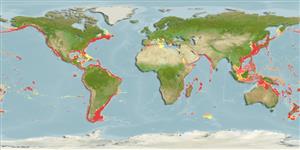Polychaeta |
Canalipalpata |
Chaetopteridae
Environment: milieu / climate zone / εύρος βάθους / distribution range
Οικολογία
; εύρος βάθους 1 - 585 m (Αναφ. 87630). Tropical
Antarctic, Atlantic, the Mediterranean and Indo-Pacific. Tropical to polar.
Length at first maturity / Μέγεθος / Weight / Age
Γεννητική Ωρίμανση: Lm ? range ? - ? cm
Found in sublittoral mudflats (Ref. 3197), on muddy fine sand (Ref. 96521), cracks between rocks and on rocky bottoms (Ref. 87630). A filter feeder and host of a parasitic porcellanid crab (Ref. 3197). Tubiculous (Ref. 112705). Feeds mainly on detritus (Ref. 96580).
Life cycle and mating behavior
Γεννητική Ωρίμανση | Αναπαραγωγή | Γεννοβολία | Eggs | Γονιμότητα | Larvae
Members of the class Polychaeta are mostly gonochoric (sexual). Mating: Females produce a pheromone attracting and signalling the males to shed sperm which in turn stimulates females to shed eggs, this behavior is known as swarming. Gametes are spawned through the metanephridia or body wall rupturing (termed as "epitoky", wherein a pelagic, reproductive individual, "epitoke", is formed from a benthic, nonreproductive individual, "atoke"). After fertilization, most eggs become planktonic; although some are retained in the worm tubes or burrowed in jelly masses attached to the tubes (egg brooders). Life Cycle: Eggs develop into trocophore larva, which later metamorph into juvenile stage (body lengthened), and later develop into adults.
Gibbs, P.E. 1978 Macrofauna of the intertidal sand flats on low wooded islands, Northern Great Barrier Reef. Philosophical Transactions of the Royal Society of London, Series B 284(999):81-97. (Αναφ. 3197)
IUCN Red List Status
(Αναφ. 130435: Version 2025-1)
CITES status (Αναφ. 108899)
Not Evaluated
Not Evaluated
Threat to humans
Human uses
| FishSource |
Εργαλεία
Περισσότερες πληροφορίες
Population dynamicsΑύξησηMax. ages / sizesLength-weight rel.Length-length rel.Length-frequenciesMass conversionΑφθονία Life cycleΑναπαραγωγήΓεννητική ΩρίμανσηΓονιμότηταΓεννοβολίαEggsEgg developmentLarvae PhysiologyΚατανάλωση οξυγόνου
Human RelatedStamps, coins, misc.
Διαδικτυακές πηγές
Estimates based on models
Preferred temperature
(Ref.
115969): 3.9 - 25, mean 13.8 (based on 2078 cells).
Price category
Unknown.
